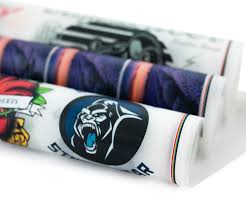Designers optimize artwork for DTF transfers through proper resolution settings, colour mode selection, and file format choices that preserve image quality during printing. These technical preparations determine whether final transfers appear sharp or pixelated, vibrant or dull. Graphic designers enhance precision by refining artwork resolution before DTF Transfers bestellen, ensuring every fine detail, gradient, and texture maintains its integrity when printed onto chosen fabrics. Resolution requirements differ from screen printing. Color considerations account for printing limitations. File preparation prevents common quality issues that emerge during production.
Color mode optimization
- RGB color space matches screen display, but requires CMYK conversion for printing, where direct RGB printing produces unexpected color shifts
- CMYK mode previews how colors translate to print, avoiding surprises when vibrant screen colors appear muddy on transfers
- Pantone spot colors need CMYK equivalents since DTF printers cannot reproduce spot color systems directly
- Color profiles matching printer specifications ensure accurate reproduction, where generic CMYK may differ from actual output
- Black elements require rich black formulations combining cyan, magenta, and yellow with black, preventing a flat gray appearance
RGB’s broader color gamut includes shades that CMYK cannot physically reproduce. Neon colors, certain blues, and saturated oranges exceed printable ranges. Designers viewing artwork in RGB often experience disappointment when printed results appear duller. Converting to CMYK during design reveals these limitations allowing color adjustments before production rather than discovering problems after printing.
File format selection
- PDF files with embedded fonts and images provide complete self-contained packages, preventing missing element errors
- TIFF format supports layers and transparency while maintaining lossless compression, preserving maximum quality
- PNG files handle transparency well, but use lossy compression, potentially degrading quality through repeated saving
- PSD native Photoshop files preserve all editing layers, though production facilities may prefer flattened versions
- EPS vector format ensures scalability, though requires conversion to raster at specified resolution before DTF printing
Layered files offer production advantages. Keeping design elements on separate layers allows last-minute adjustments without rebuilding artwork entirely. Text layers remaining editable enable quick spelling corrections or personalization changes. However, flattened versions prevent accidental modifications during production. Many designers provide both layered working files and flattened production-ready versions.
Text handling considerations
Small text presents challenges in any printing process. DTF handles fine details well, but physical limitations exist. Text below 8 points becomes difficult to read, particularly in script or decorative fonts. Simple sans-serif fonts remain legible at smaller sizes compared to ornate typefaces with thin strokes that may disappear entirely during printing. Outlining text converts fonts to shapes, preventing font substitution issues when files are transferred between computers. This conversion makes text uneditable but guarantees the design appears exactly as intended.
The tradeoff between editability and consistency requires careful consideration based on whether the design might need text changes later. Thin strokes in certain fonts may require artificially thickening during the design phase. Hairline serifs or delicate script flourishes that look beautiful on screen sometimes fail to transfer properly. Slightly bold versions maintain character while ensuring printability. Testing problematic fonts through sample prints reveals whether modifications prove necessary before committing to production quantities.
Design software separates these layers, allowing precise control over white ink application. This separation proves particularly important for cost estimation since white ink consumption significantly impacts transfer pricing. These technical considerations determine whether designs translate successfully from digital files to finished transfers. Attention to these details during the design phase prevents quality issues and production delays requiring artwork revisions.




